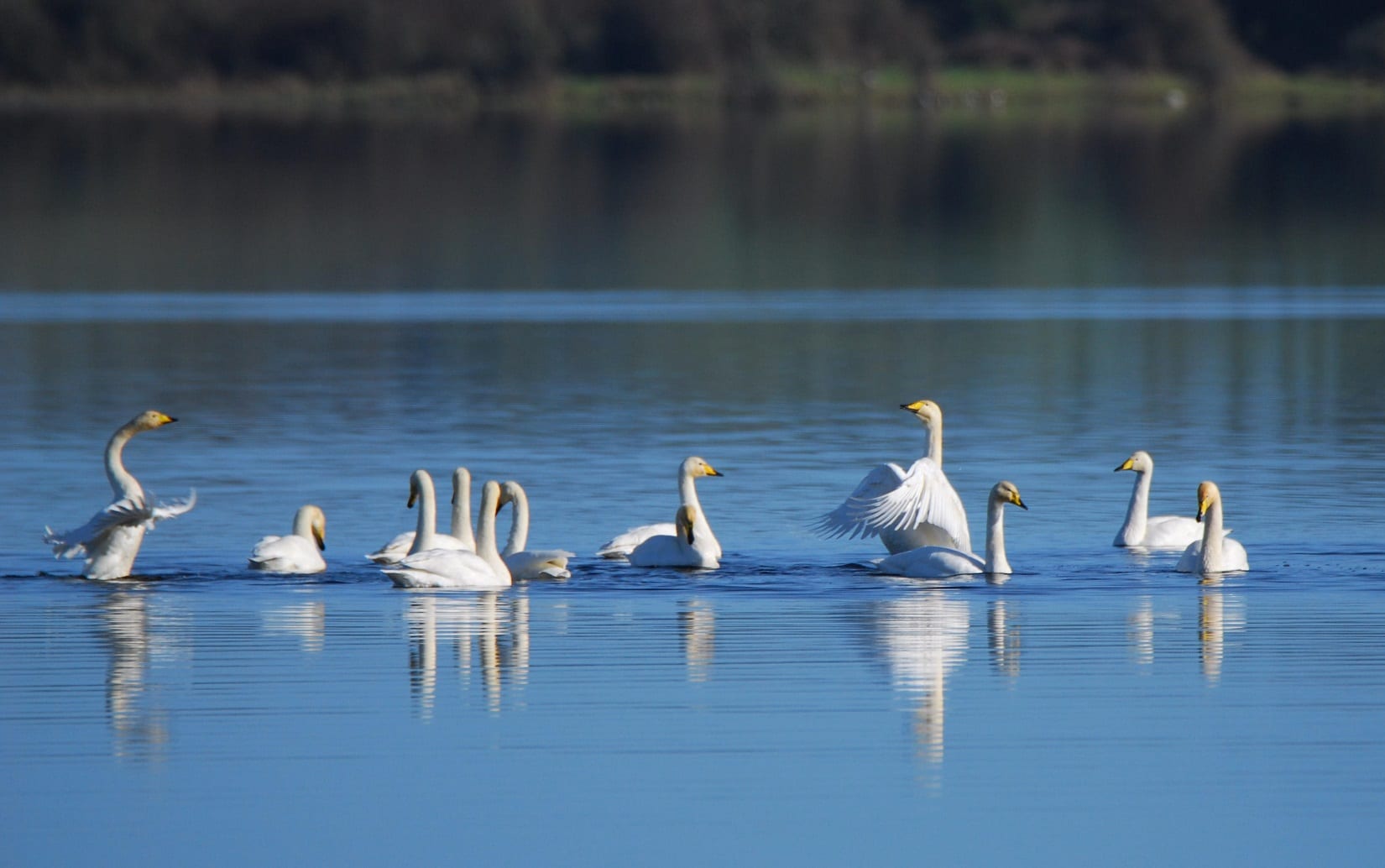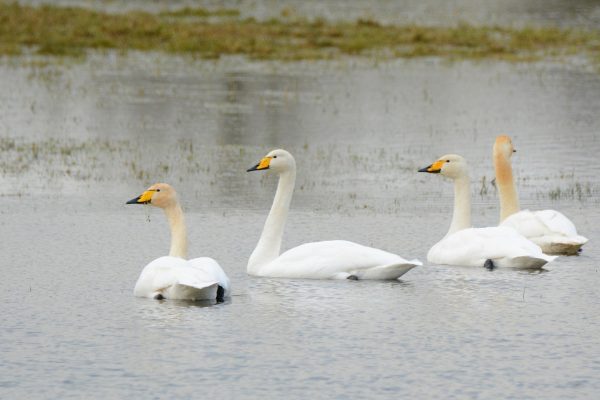
Whooper Swan
| Irish Name: | Eala Ghlórach |
| Scientific name: | Cygnus cygnus |
| Bird Family: | Swans |
amber
Conservation status
Conservation status
Status
Winter visitor to wetlands throughout Ireland from October to April.
Identification
Similar to Bewick's Swan, but larger, with longer neck. Yellow and black bill, with the yellow projecting below the nostril.
Voice
Vocal bugling or honking.
Diet
Aquatic vegetation, but they are commonly found grazing on agricultural grasslands and fields where there is spilled grain, as well as potatoes from cultivated land.
Breeding
The Whooper Swans that are present in Ireland each winter nest in Iceland during the summer. Each year a small number of Whoopers stay in Ireland for the summer and there have been occasional breeding records on lakes in the midlands and north-west.
Wintering
Most on lowland open farmland around inland wetlands, regularly seen while feeding on grasslands and stubble.
Monitored by
Irish Wetland Bird Survey (I-WeBS), and a special swan census is carried out every five years, most recently in 2020. The census takes place in January and aims to count and gather data on every Whooper Swan in Ireland. The census is coordinated in the Republic of Ireland by our I-WeBS team.
Blog posts about this bird

International Swan Census will take place in January 2026
The results of the last International Swan Census in 2020 showed an increase in Whooper Swan numbers in Ireland – up 24.9% in the Republic of Ireland and up 32% in Northern Ireland – compared to the previous census in 2015. At 19,111 birds, this was the highest number recorded in Ireland to date (14,467 in Republic of Ireland and 4,644 in Northern Ireland).
Nevertheless, the proportion of the overall Icelandic-breeding flyway population of Whooper Swans that winter in Ireland is actually decreasing. This is largely due to an increase in the number of birds at sites in England, where there were rapid rises recorded at some key sites.
All of the Icelandic-breeding Whooper Swan population winters in Ireland and Great Britain (with a very small number wintering in the Channel Islands and Isle of Man), while a proportion remains in Iceland. A total of 43,255 birds was recorded across this region in 2020, with ~49% occurring in Britain, ~44% on the island of Ireland, and ~7% overwintering in Iceland. With Ireland supporting such a significant proportion of the international population of this species it is critical that we regularly assess how the birds are faring.




World Migratory Bird Day campaign underscores the importance of insects and shines a light on declines
Saturday, October 12th marks World Migratory Bird Day. By focusing their 2024 campaign on insects, organisers hope to underscore their importance to migratory birds while also highlighting wider concerns related to decreasing insect populations.
The importance of insects for migratory birds and all life
We often hone in on the long distances travelled by migratory bird species and rightly so. It is extremely impressive that such small creatures can fly thousands of miles, often in challenging weather conditions, and arrive at their destination safely. However, many birds are reliant on other species to make this journey possible. Indeed, it is the existence of other winged creatures – insect populations – that gives them the fuel to keep on going.
Insects are essential food sources for many migratory birds on their long journeys, and some species will time their migrations to align with periods of insect abundance in their stopover locations. Once they replenish their energy reserves, they can resume their journey.
Species such as warblers, flycatchers, swallows, and swifts are particularly reliant on insects. However, many other bird species such as ducks and shorebirds depend on insects during migration and at other stages in their lifecycle, in particular for raising their young before they are able to fly.
On a wider level, insects provide critical ecosystem services that support all life on this planet. They pollinate crops which supports food production, decompose waste materials and contribute to nutrient cycling and soil fertility, and control pests. Their decline has a direct impact on ecosystem functioning.
Insect Declines
Many people will recall how, not so long ago, a large number of dead insects would be found on a car windscreen and bumper following a drive through the countryside. Those too young to have experienced this period of insect abundance are likely to have heard this anecdote from friends and family. In fact, it is such a widely shared observation that it has become known to entomologists as the “the windshield phenomenon”.
Anecdotally, insects have experienced declines, but what does the science say? Unfortunately, invertebrates including insects have been historically understudied and many gaps in the data still remain. Additionally, where assessments have taken place, they have predominantly been in regions that can afford to fund insect science such as Europe and North America. Some of the most biodiverse regions on the planet have had little to no assessments of their insect populations. This lack of data on the species we know, coupled with the fact that millions of insect species are yet to be discovered, suggests that we don’t have the full picture on the scale of global insect decline.
However, in recent decades, efforts to better understand how insects are faring have expanded with pollinating insects such as bees, hoverflies, butterflies and moths in particular becoming the subject of an increased amount of research. From what we know so far, the situation is clear: they are in peril.
For example, the International Union for Conservation of Nature (IUCN) European Red List of Bees shows that 9% of the 1,965 species of bee in Europe are Threatened with extinction mainly due to habitat loss as a result of agriculture intensification, urban development, increased frequency of fires and climate change. A further 5.2% are considered Near Threatened. However, a staggering 56.7% of these species were classified as “Data Deficient” meaning that there is not enough data to evaluate their risk of extinction.
Over 37% of the European hoverfly species assessed in the IUCN European Red List of Hoverflies were considered Threatened, with a further 6.9% considered Near Threatened. One species that previously occurred in Sweden, Finland and possibly Poland, was classified as Regionally Extinct.
As outlined in their Red List Strategic Plan (2021-2030), the IUCN is working to substantially increase the number of wild species assessed, particularly plants, invertebrates and fungi.
Insects in Ireland
In Ireland, the National Biodiversity Data Centre is doing trojan work to improve our knowledge of insect populations in Ireland, particularly via monitoring schemes for butterflies, bumblebees and more recently, dragonflies.
The Irish Butterfly Monitoring Scheme, established by the Data Centre in 2008, is Ireland’s longest-running citizen science insect monitoring scheme. By tracking changes in 15 species, we now know that overall butterfly populations have declined by 55% since 2008.
Meanwhile, the All-Ireland Bumblebee Monitoring Scheme has been tracking changes in the populations of the eight most common bumblebee species since 2012. The current overall trend from 2012-2023 is a year-on-year decline of 3.3%.
Celebrate World Migratory Bird Day
World Migratory Bird Day is an annual global campaign dedicated to raising awareness of migratory birds and the need for international cooperation to conserve them. It is organised by a collaborative partnership among two UN treaties – the Convention on Migratory Species (CMS) and the African-Eurasian Migratory Waterbird Agreement (AEWA) – and the non-profit organisation, Environment for the Americas (EFTA).
The return of winter migrants to Ireland brings a seasonal spectacle as thousands of birds, such as Whooper Swans, Greenland White-fronted Geese and Greylag Geese arrive from colder northern regions. This annual migration highlights Ireland's role as a vital sanctuary, providing essential habitats for these species during the harsher winter months. Keep an eye out for some of these species this World Migratory Bird Day but be sure to keep your distance to avoid harmful disturbance.
This year’s insect theme may also encourage you to play your part for Ireland’s insect populations. One way you can do this is by getting involved in the National Biodiversity Data Centre’s citizen science initiatives. Find out more here.












